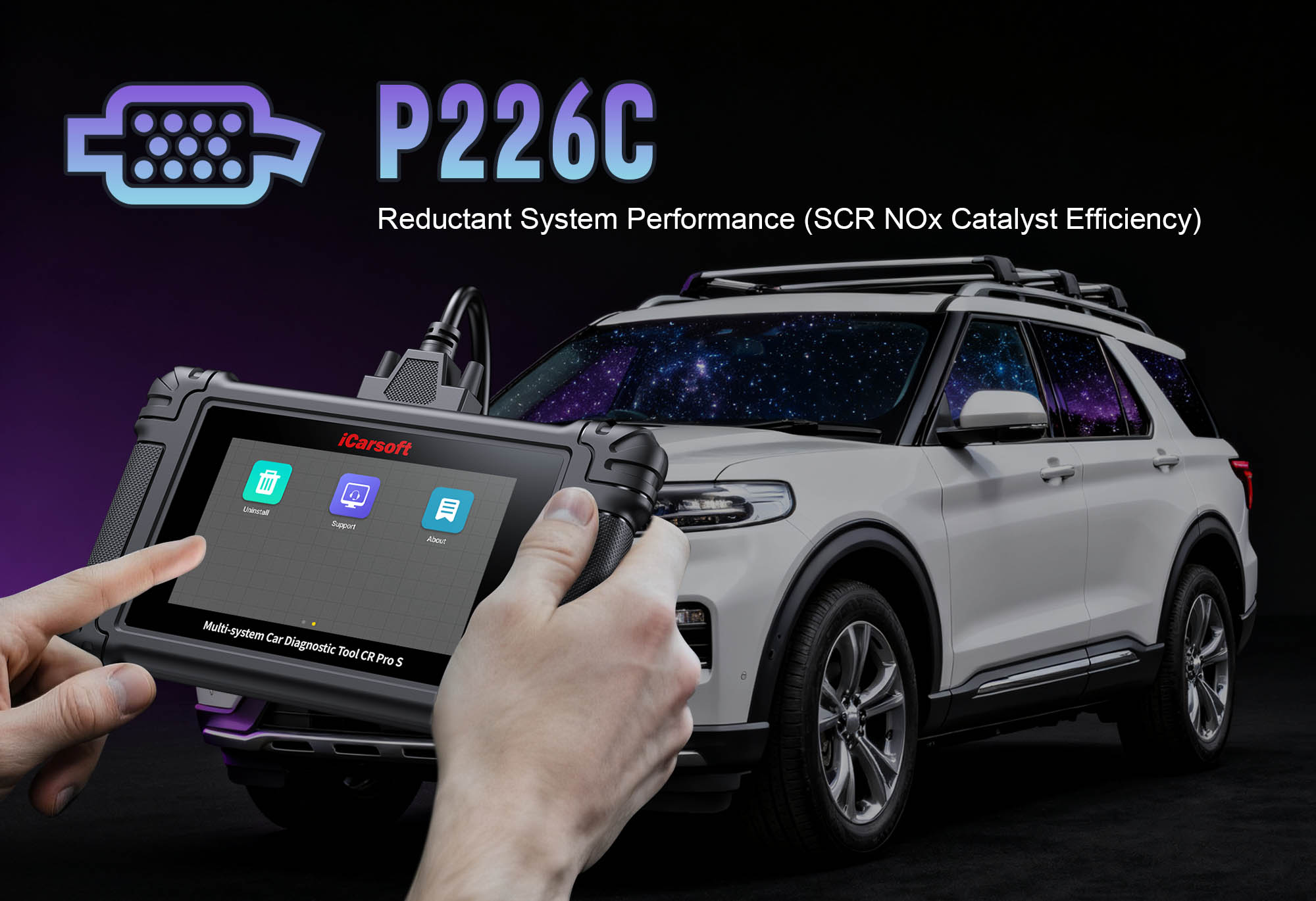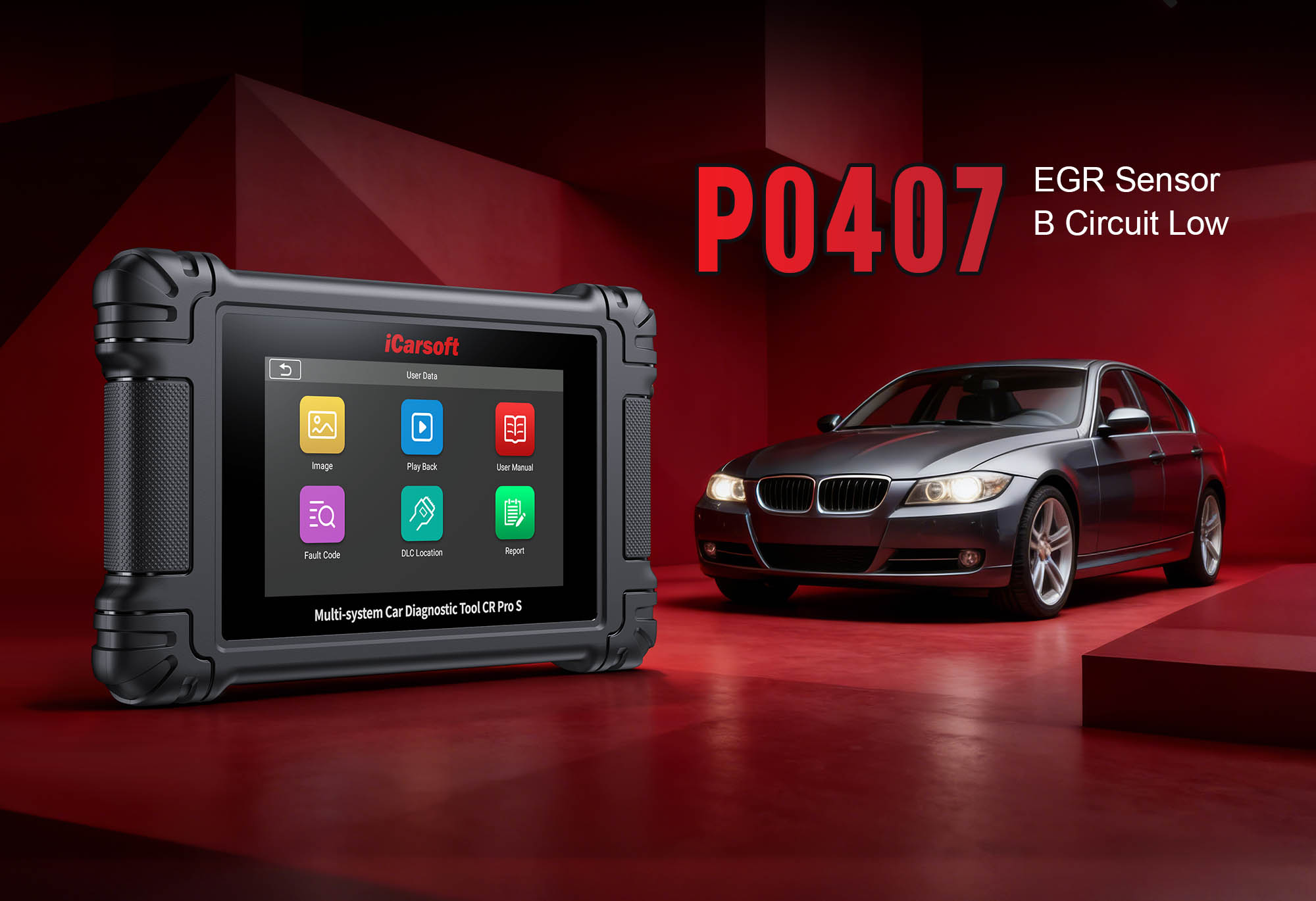P226C Code: Diagnose & Clear Diesel Particulate Filter (DPF) Pressure Sensor A Circuit High with iCarsoft CR Pro S
If your diesel vehicle’s check engine light illuminates and you notice reduced engine power, increased exhaust smoke, or a "DPF Full" warning, a diagnostic scan will likely return P226C. This OBD-II code stands for "Diesel Particulate Filter (DPF) Pressure Sensor A Circuit High," indicating the Engine Control Module (ECM) is receiving an abnormally high voltage signal from the DPF pressure sensor—a critical component that monitors soot buildup in the particulate filter.
Diesel engines produce soot during combustion, which the DPF traps to meet emissions standards. The DPF pressure sensor measures the pressure difference before and after the filter: as soot accumulates, pressure increases, signaling the ECM to initiate a regeneration cycle (burning off soot at high temperatures). A "circuit high" error means the sensor is sending voltage above the normal range (typically >4.5V, vs. the standard 0.5–4.5V), often due to sensor failure, wiring shorts, or a clogged DPF. Left unaddressed, P226C can trigger limp mode, damage the DPF, or cause costly emissions system failures.
Basic scanners may only flag "DPF pressure fault" but can’t test sensor functionality or distinguish between electrical and mechanical causes. The iCarsoft CR Pro S, with its DPF system diagnostics, live pressure monitoring, and regeneration controls, solves this. Let’s walk through how to diagnose and resolve P226C with precision.
Understanding P226C: Causes & Key Symptoms
A faulty DPF pressure sensor disrupts soot monitoring, with symptoms that worsen as the filter clogs or the circuit degrades—these clues help separate electrical (sensor/wiring) from mechanical (DPF clog) causes.
Key Symptoms of P226C
-
Reduced Engine Power: The ECM limits RPM to 2,000–3,000 to prevent overloading a potentially clogged DPF.
-
Increased Exhaust Smoke: Unburned fuel or soot escapes due to incomplete regeneration (caused by incorrect pressure data).
-
DPF Warning Lights: Diesel vehicles (Ford Power Stroke, Dodge Cummins, VW TDI) trigger "DPF Full" or "Regeneration Required" lights.
-
Failed Emissions Tests: High soot levels from an unmonitored DPF exceed legal limits.
-
Limp Mode Activation: The ECM locks the engine in low power to avoid damaging the turbocharger or exhaust system.
-
Intermittent Issues: High voltage may occur only when hot (wire expansion) or vibrating (loose connectors).
Common Causes of P226C
|
Cause
|
Description
|
|
Faulty DPF Pressure Sensor
|
Internal electrical failure causes constant high voltage (>4.5V) to the ECM—common in high-mileage diesel vehicles.
|
|
Wiring/Connector Short
|
A frayed wire touches a 12V source (e.g., battery cable), creating a high-voltage short in the sensor circuit.
|
|
Clogged DPF Pressure Lines
|
Soot or moisture blocks hoses connecting the sensor to the DPF, causing false high-pressure readings.
|
|
Severely Clogged DPF
|
Excessive soot buildup creates extreme pressure (>50 psi), overwhelming the sensor and triggering high voltage.
|
|
ECM Malfunction
|
Outdated firmware or internal faults misinterpret sensor voltage—rare but possible in 2015+ diesel models.
|
|
Water Intrusion
|
Moisture in the sensor connector (off-road/wet climates) corrodes pins and disrupts voltage signals.
|
Why iCarsoft CR Pro S Excels at Diagnosing P226C
The CR Pro S outperforms basic tools with diesel-specific DPF features, critical for isolating the root cause of P226C:
Live DPF Pressure & Voltage Tracking
Monitors real-time pressure differentials and sensor voltage, making abnormal high signals easy to identify.
DPF Regeneration Control
Initiates manual regeneration to clear soot—verifies if the issue is a clogged DPF or faulty sensor.
Circuit Short Testing
Detects short-to-power faults in wiring/connectors—avoids replacing sensors when the issue is electrical.
Global Diesel Coverage
Works with 500+ diesel models (Ford, Dodge, Mercedes-Benz, VW) for brand-specific DPF system variations.
DPF Health Reports
Analyzes long-term pressure data to flag filter degradation or sensor drift (early P226C signs).
Lifetime Free ECM Updates
Wi-Fi updates fix P226C false triggers from outdated ECM software (common in diesel emissions recalibrations).
Step-by-Step: Diagnose P226C with iCarsoft CR Pro S
-
Check for Obvious DPF or Sensor Issues
1. DPF Pressure Lines: Locate hoses (use Component Location tool) — check for cracks, kinks, or soot clogs (squeeze to feel blockages).
2. Sensor Connector: Inspect for corrosion, bent pins, or moisture—clean with electrical contact cleaner if needed.
-
Connect the CR Pro S & Confirm the Code
1. Plug the CR Pro S into the OBD-II port (use OBDI adaptors for older diesels: Mercedes 38Pin).
2. Select your vehicle via Auto VIN Identify (instant specs) or manual entry.
3. Navigate to Engine > Fault Codes > Read Codes to confirm P226C. Tap Code Details for tips (e.g., "Ford F-250: Check Sensor Near Exhaust Manifold").
-
Locate the DPF Pressure Sensor & System Components
1. Go to Component Location > Engine > Emissions > DPF > Pressure Sensor.
2. Use the diagram to identify:
- DPF Pressure Sensor: On exhaust manifold/DPF housing (2 hoses + 3-pin connector).
- DPF Housing: Check for heat discoloration or damage.
- Pressure Lines: Rubber/metal hoses connecting sensor to DPF.
- Wiring Harness: Path to ECM (check for exhaust heat damage).
-
Analyze Live DPF Pressure & Sensor Voltage Data
1. Start the engine, let it reach operating temperature (10–15 minutes for diesels).
2. Navigate to Engine > Live Data > DPF System and monitor:
- Sensor Voltage: Normal = 0.5–4.5V. P226C = >4.5V (constant high).
- Pressure Differential: Normal = 1–5 psi (idle), 10–30 psi (load). >50 psi = severely clogged DPF.
- Regeneration Status: Voltage should spike temporarily during regen. Stuck high = sensor/circuit fault.
- ECM Reference Voltage: Should be 5V (under Live Data > ECM Power). >5.2V = ECM issue.
-
Test the DPF Pressure Sensor Circuit for Shorts
1. Short-to-Power Test: - Turn off engine, disconnect sensor connector.
- Use Multimeter Function:
- Signal pin → ground: Normal = 0V. >0V = wire shorted to 12V source.
- Power pin → ground: Normal = 5V. >5.2V = ECM overvoltage (consult pro).
2. Continuity Test: - Measure resistance between sensor signal pin and ECM pin (use wiring diagram). Normal = <5 ohms. Higher = frayed wire/corrosion.
-
Perform a Manual DPF Regeneration
1. Regeneration Readiness Check: - Go to Special Functions > Engine > DPF Regeneration > Check Readiness. Ensure engine temp >180°F and fuel tank >1/4 full.
2. Initiate Regeneration: - Select "Start Regeneration"—ECM heats exhaust to 1,000–1,200°F to burn soot.
- Monitor: Pressure differential drops to <20 psi = DPF fixed. Persistent high voltage = faulty sensor.
-
Test the DPF Pressure Sensor
1. Sensor Bench Test: - Remove sensor (use Torque Guide), disconnect pressure lines.
- Apply 5–10 psi air to inlet port; measure voltage with multimeter. Normal = voltage rises smoothly. No change = faulty sensor.
2. Replacement Calibration: - Install new OEM sensor (use Part Lookup). Run DPF Sensor Calibration (Special Functions) to sync with ECM.
-
Inspect for Severe DPF Damage
1. DPF Physical Inspection: - Have a pro remove the DPF housing. Check for solid soot blockages (hardened = replace) or cracks.
2. DPF Replacement Teach-In: - If replaced, use DPF Replacement Teach-In tool to register new filter with ECM.
-
Rule Out ECM Issues
1. ECM Firmware Update: - Go to System > Update Manager to install free updates (fixes misinterpreted pressure data).
2. ECM Communication Test: - Verify module receives sensor signals. Failed communication = ECM repair (rare).
-
Repair & Clear P226C
1. Fix the root cause:
- Electrical Faults: Repair shorted wiring, clean connectors.
- Faulty Sensor: Replace and calibrate DPF pressure sensor.
- Clogged DPF: Perform manual regeneration or replace filter.
- ECM Issues: Update firmware or repair module.
2. Clear the code: Navigate to Engine > Fault Codes > Clear Codes to delete P226C.
-
Validate the Repair
1. Recheck live data: Sensor voltage = 0.5–4.5V; pressure differential normal under load.
2. Test drive 50+ miles (include highways for natural regen): No warning lights or reduced power.
3. Post-drive scan: Use DPF System Scan after 100 miles to confirm P226C doesn’t return.
Preventing P226C Recurrence
Use the iCarsoft CR Pro S to maintain DPF and sensor health long-term:
-
Regeneration Reminders: Set Service Reminder for manual regeneration every 10,000 miles (or if "DPF Full" appears).
-
Sensor Checks: Include DPF pressure sensor in annual diesel scans—test voltage and continuity.
-
Pressure Line Maintenance: Inspect and clean lines yearly to prevent soot/moisture clogs.
-
Fuel Quality Tracking: Use Fuel System Health Log to monitor injector performance—poor fuel accelerates DPF clogging.
Conclusion
P226C’s high-voltage DPF pressure sensor fault threatens diesel performance and emissions compliance—but the iCarsoft CR Pro S simplifies diagnosis with live data, regeneration controls, and electrical tests. Whether replacing a sensor, clearing a clogged DPF, or updating the ECM, this tool ensures you fix the root cause (not just the symptom).
With the CR Pro S, you’ll restore proper DPF monitoring, avoid limp mode, and keep your diesel vehicle running efficiently—no more costly dealer visits or failed emissions tests.
FAQs About P226C Code
Q: Can I drive with P226C?
A: Short trips (to a repair shop) are possible, but prolonged driving causes DPF damage or limp mode. Address P226C within 1–2 days to avoid costly repairs.
Q: How much does it cost to fix P226C?
A: $150–$350 for an OEM DPF pressure sensor; $200–$500 for DPF cleaning/regeneration; $1,500–$4,000 for DPF replacement (if damaged). The CR Pro S ($300–$400) saves by avoiding unnecessary filter replacement.
Q: Will a DPF delete fix P226C?
A: DPF deletes are illegal in most regions (violates emissions laws) and may void your vehicle warranty. Use the CR Pro S to fix the root cause (sensor/wiring/DPF clog) instead.
Q: Why does P226C come back after clearing?
A: The root cause wasn’t fixed—e.g., a clogged DPF wasn’t regenerated, or a shorted wire wasn’t repaired. Use the CR Pro S’s live data to recheck pressure and voltage after clearing.





